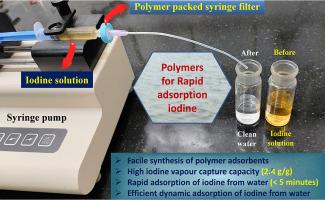利用链烯交联多孔有机聚合物快速吸附水中的碘并可逆捕获碘蒸气
IF 6.3
2区 工程技术
Q1 ENGINEERING, CHEMICAL
引用次数: 0
摘要
在这项研究中,我们报告了具有显著孔隙率的中性和离子多孔有机聚合物的合成和表征。这些聚合物的碘蒸气捕获能力高达 ~2.41 gg-1,并能在振荡 5 分钟内快速吸附水中的碘。这些聚合物在多次循环中也表现出卓越的可回收性。更重要的是,动态流动实验证实了它们作为过滤材料在实际应用中的潜力。选择性研究表明,即使在溴化物、氯化物、硝酸盐和硫酸盐等竞争阴离子存在的情况下,这两种聚合物也能保持较高的碘去除效率,这突出表明了它们在复杂环境中的稳定性。这些发现凸显了这些聚合物在过滤和吸附过程中的巨大潜力,尤其是在捕获和去除核废水中的碘方面。本文章由计算机程序翻译,如有差异,请以英文原文为准。

Rapid adsorption of iodine from water and reversible capture of iodine vapor using stilbene-crosslinked porous organic polymers
In this study, we report the synthesis and characterization of neutral and ionic porous organic polymers with significant porosity. The polymers exhibited high iodine vapor capture capacities up to ~2.41 gg−1 and also displayed rapid adsorption of iodine from water within 5 min of shaking. The polymers also showed excellent recyclability over multiple cycles. More importantly, dynamic flow-through experiments confirmed their potential as filtration materials for practical applications. Selectivity studies revealed that both polymers maintained high iodine removal efficiency even in the presence of competing anions such as bromide, chloride, nitrate, and sulfate, underscoring their robustness in complex environments. These findings highlight the significant potential of these polymers in filtration, and adsorption processes, particularly for iodine capture and removal from nuclear waste water.
求助全文
通过发布文献求助,成功后即可免费获取论文全文。
去求助
来源期刊

Journal of water process engineering
Biochemistry, Genetics and Molecular Biology-Biotechnology
CiteScore
10.70
自引率
8.60%
发文量
846
审稿时长
24 days
期刊介绍:
The Journal of Water Process Engineering aims to publish refereed, high-quality research papers with significant novelty and impact in all areas of the engineering of water and wastewater processing . Papers on advanced and novel treatment processes and technologies are particularly welcome. The Journal considers papers in areas such as nanotechnology and biotechnology applications in water, novel oxidation and separation processes, membrane processes (except those for desalination) , catalytic processes for the removal of water contaminants, sustainable processes, water reuse and recycling, water use and wastewater minimization, integrated/hybrid technology, process modeling of water treatment and novel treatment processes. Submissions on the subject of adsorbents, including standard measurements of adsorption kinetics and equilibrium will only be considered if there is a genuine case for novelty and contribution, for example highly novel, sustainable adsorbents and their use: papers on activated carbon-type materials derived from natural matter, or surfactant-modified clays and related minerals, would not fulfil this criterion. The Journal particularly welcomes contributions involving environmentally, economically and socially sustainable technology for water treatment, including those which are energy-efficient, with minimal or no chemical consumption, and capable of water recycling and reuse that minimizes the direct disposal of wastewater to the aquatic environment. Papers that describe novel ideas for solving issues related to water quality and availability are also welcome, as are those that show the transfer of techniques from other disciplines. The Journal will consider papers dealing with processes for various water matrices including drinking water (except desalination), domestic, urban and industrial wastewaters, in addition to their residues. It is expected that the journal will be of particular relevance to chemical and process engineers working in the field. The Journal welcomes Full Text papers, Short Communications, State-of-the-Art Reviews and Letters to Editors and Case Studies
 求助内容:
求助内容: 应助结果提醒方式:
应助结果提醒方式:


